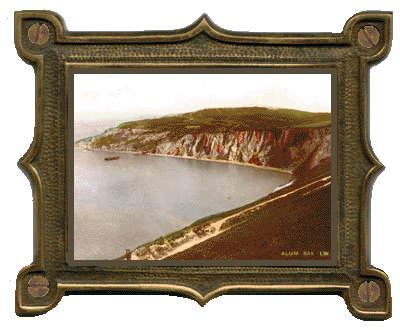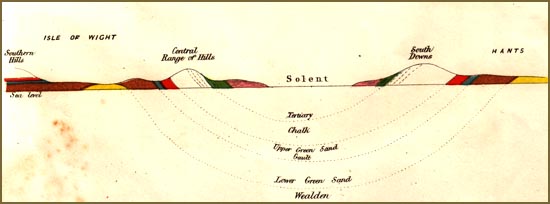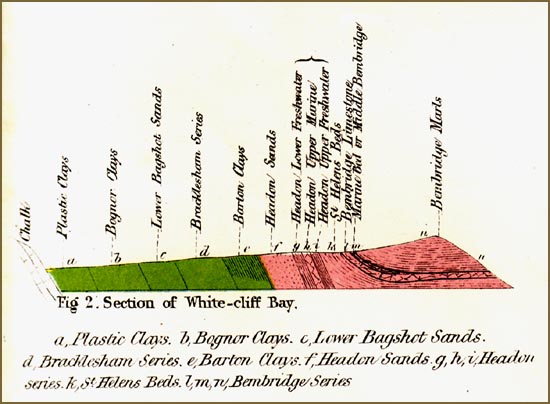
| 
|

 EPSOM AND EWELL WELLS - Chapter 13
EPSOM AND EWELL WELLS - Chapter 13Epsomite Stratigraphy elsewhere
Dr Bruce E Osborne
Isle of Wight.
13.1. Alum Bay from a 20th century postcard.
An excursion to the Isle of Wight may at first appear out of place in a dissertation on Epsom salts. The 1769 Lloyds Evening Post history of Epsom points out that Ebba, the Christian Queen who erected a mansion at Epsom, was first created Queen of the Isle of Wight.[1] It would have been agreeable to have accepted this link but unfortunately the Lloyds editorial and subsequent similar texts are incorrect. Ebbi, the man whose name appears on the 10th century charter granting away Epsom, is not the same person as Ebbe, the 8th century woman recorded as Queen and Saint of the Isle of Wight.[2] There is however a link of a different nature between Epsom and the Isle of Wight. It will be shown that such a digression yields particularly important background information. We are able to discover fresh facts concerning the Tudor awareness and management of Epsom salts. In addition there are new insights to be gleaned about the geology of the Tertiary beds of the London basin and the background to the discovery of the mineralised springs. Before embarking on this excursion it is necessary to set the scene.
Chemistry in the modern sense emerged about 1800, when elements were being discovered following Boyle's ideas on the chemical element in the 17th century. It was another 100 years however before the essential distinction between elements and compounds could be made.[3] Before 1800 science applied a variety of tests to mineral waters in order to ascertain their contents and efficacy but there was little understanding of the true nature of the elements and compounds contained therein. This is apparent in the early descriptions of the contents of Epsom wells. In 1660, Thomas Fuller, cited earlier, describes the mineralisation as aluma. Celia Fiennes also wanders into a technical description in the early 1690s when she compared Epsom with the springs on Blackheath. Like Epsom, she thought the springs were very quick purgers due to "allum".[4]
Alum we now know to be a compound. It is generally considered to be a double sulphate of aluminium and another element, especially potassium or iron. Aluminium as such was not discovered until 1827. Before the advent of chemistry the term alum or allum was a generic description which encompassed a range of sulphate minerals. This even occasionally included the "hydrogen sulphate" or sulphuric acid, once known as vitriol. Muspratt as late as 1858 discusses a cocktail of sulphates described as alum liquors, a point considered in more detail later. The term Epsom salts was applied to the Epsom type of mineralisation after Grew's evaporation of the mineralised waters in the 17th century. The range of minerals occurring as a result of marine evaporation and which would have fallen into the category of alums can be deduced from the research into the Stassfurt series in Germany. These include anhydrite CaSO4, gypsum CaSO4.2H2O, kainite KMgClSO4.11/4H2O, kieserite MgSO4.H2O, langbeinite K2Mg2(SO4)3.2H2O and schoenite K2Mg(SO4)2.6H2O. The minerals containing the MgSO4 occur in greater profusion away from the margins of the geological basin.[5] Other sulphates occurring in mineral waters include Glauber Salts from Franzenbad in the Czech Republic, CaSO4.Na2SO4, glauberite.
The elements contained within the alums include O, Mg, S, Ca and Al. These are five of the most prolific eight elements on earth; together they comprise 99 percent of the earth's mass.[6]
Alums have long been known for their uses and have an extended history of exploitation. Alum was known to the ancient Greeks and Romans. Pliny quoted from Dioscorides, identifying numerous Mediterranean countries where it was obtained. Its use, depended on its nature, which suggests varying chemical composition; it was particularly valuable for dyeing to produce bright colours, as an injection for dysentery and as a gargle. During the 15th century Turkey was a key world source of industrial alum. Following technical research and development in Italy the Pope was able to establish a monopoly on the manufacture of alum for industrial and medicinal purposes. This was something that both Henry VIIIís and Elizabeth I's administration sought to escape from by the establishment of a home based industry.[7] Its uses were varied. Agricola (1556) used alum in compositions to separate silver from gold and copper from gold.[8] In The Secrets of Art and Nature (1660), a great encyclopaedia of ancient wisdom, alum turns up in the secrets of quicksilver. It is used for the fireproofing of wood and for recolouring hair golden.[9] This in turn raises the question how was it obtained at this early date? In the 16th century it was recovered from shales where it occurred in veins and from alum rock.[10] An excursion to the Isle of Wight throws important further light on the subject.
Worsleys much respected 1781 History of the Isle of Wight mentions how Dr Fraser, Physician to Charles II visited the Island in 1781. Here he discovered a spring at Shanklin that contained alum. (page 5) This spring subsequently enjoyed repute as a spa and healing spring contemporary with Epsom Wells.
The Isle of Wight has a unique geology which peculiarly imitates the geology of the North Downs and London Basin. Epsom is sited at the juncture of the North Downs and London Basin. The geological strata in the Isle of Wight replicates this because the south east of England comprises an eroded anticline forming the Weald and then a syncline forming the Solent Basin. Erosion has removed the overlying beds in many places, exposing the early Cretaceous strata, as in the Central Weald. The sequence of beds however remains more or less constant throughout. The result is that abutting the northern side of the east-west central chalk downland ridge of the Isle of Wight are the overlying Tertiary stratum of the Reading Beds and London Clay, similar to the geological circumstances in which Epsom lies. The Reading Beds are considered the source of Epsom salts.

13.2. The Solent syncline with continuity of strata demonstrated.
The angle of dip of the strata in the Isle of Wight is near vertical. This is due to folding which has distorted the beds through an angle of about 90 degrees. In the Epsom area the beds are dipping to the north beneath the London Basin at a shallow angle. The Isle of Wight, being an island, provides an opportunity to view the cross section of the chalk and associated beds on the coast, where the wave cut platform has exposed the strata. This particularly applies at Whitecliffe Bay on the eastern tip of the Island. Here the Chalk cliffs majestically face the sea and, to the north, are immediately bounded by the Reading Beds and the London Clays. Walking towards the chalk cliff along the beach the stratigraphy of the cliffs on the right replicates the stratigraphy of a well in the Epsom region, albeit turned through 90 degrees. This is uncannily similar to Whitaker's Epsom borehole stratigraphy cited in Chapter 13.

13.3. Early section of Whitecliffe Bay, the plastic clays are the Reading Beds, the Bognor Clays the London Clays.
Of particular interest is the occurrence of the ferruginous sand corresponding to the glauconite bed on the mainland. This lies directly against the Cretaceous chalk which was eroded before the deposition of the later Tertiary beds. The anciently eroded and recently exposed face of the chalk shows the characteristic choked solution hollows; these are larger in western Wight than in eastern. Then follow the coloured clays of the Reading Beds and then the sandy clays of the London Clays.
Traversing the Island it comes as no surprise to discover that the same sequence is repeated as a mirror image at the western extremities. Alum Bay and the Needles have long been a major tourist attraction on the Isle of Wight. The present day theme park however ignores the early importance of the site. The near vertical beds of the Tertiaries have given rise to a former tourist industry based on filling glass tubes and bottles with the colourful sedimentary deposits. Collecting the coloured sands of the cliffs abutting the chalk headland and The Needles has proved a popular holiday activity for many throughout the nineteenth and twentieth centuries.

13.4: Alum Bay mid 19th century. [12]
Like Whitecliffe Bay in the east, mineral springs erupt from the cliffs and add to the general erosion of the softer Tertiaries leaving the chalk outstanding. The following section is given by Osborne White for the Reading Beds at Alum Bay.[13]
Red and white mottled clay (with ferruginous parting at 4 ft.) 25 ft.
Ferrugionous-brown clayey sand 14ft.
Bright-red and white mottled clay (pipe clay) 20ft.
Brown and grey sandy clay (with a bed towards the middle of dark-red clay 3ft. thick) 10ft.
Tenacious, wet, red and white mottled clay 3ft.
Tenacious blue and brown ferruginous clay 8ft,
Brown clay covering an uneven eroded chalk surface 3-4ft
Total 84 feet.
Although the Reading Beds as they occur on the Isle of Wight vary from those in the locality of Epsom, the similarities between the Wight section and Whitaker's Epsom borehole section quoted earlier are obvious. The sequence also gives an indication of what might be expected at other mineralised wells in the Epsom district.
Earlier it was outlined how and why magnesium sulphate had been classified as alum by earlier writers. The name Alum Bay as the place where the Reading Beds are exposed as a cliff indicates that the occurrence of alum had not gone unnoticed. In fact Alum Bay has a history of industrial extraction of minerals including pipe clay (like that at Cheam, near Epsom) and fine sands for glass making.[14] Much of the severe cliff erosion may well be due to the excesses of earlier mining rather than the enthusiasm of the gatherers of coloured sands. This makes the stratigraphy much harder to discern than at Whitecliffe Bay. Such extractive industries eventually gave way to the later tourism industry. It is recorded in popular guides of the Island that the alum occurs as a yellow deposit visible in the clays and has been used for fireproofing, sizing paper, dyeing and tanning skins.[15]
More detailed research yields facts that are particularly relevant to understanding the advent of Epsom Spa. Warner (1795) identifies the "fossil salt" found at the bay as native alum or "alumen commune". It was a salt of great importance particularly for its use in medicine. The quarrying of alum was a state monopoly with contractors being appointed by the crown. This practice was started by Henry VIII who "laid his sacred hands on the manufactory of allum soil carried on here"[16], that is in the Isle of Wight. Elizabeth I's administration, having learnt of the natural source on the Island, instructed the Governor of the Island, Richard Worsley, to investigate and secure the supply as follows.[17] This was to give rise to the name for the location.
"After my right harty comendacons - Whereas the Quean's Maty being infermyd that there is wt in that Ile certen Oure of Alume. For trial and Profe wherof her Highness purtly sendeth thider the Bearer herof one Bendall. These shall be in her Mat's. name to require you with your Authorite and favir. so to assist him in that behalf, as he may revise syche partes there as he shall thynk to be meete for the pr.pose and bring wt. him some part of sayde Oure to th'end he maye therof make sume profe here wt. in the Realme. In this part as her Highness trusteth, you will give order that no man there shall impede and resist him; so he hath Charge to use himself with syche moderation and respect of behavior as shall apperteyne. And thus I byd You hartely well to fare. Fro the Court at Westmynster the 7th. daye of Marche 1561; you assured Frend, W Cecil."[18]
The sequestration and contracting of mineral rights by the Crown was part of an endeavour to break overseas monopolies; in the case of alums, that of the Pope. In a grant of 1565 Elizabeth confers mining rights elsewhere for "allom and copperas" on Cornelius de Voz, one of several German mining specialists who brought experience and expertise to the British industry.[19] Elizabeth's administration knew the value of alum as a medicinal and industrial product, and they wanted to break the Pope's monopoly on production.
We can now speculate about alum in the context of deliberations on Epsom and Ewell's balnea. Medical alum would have been available to both Henry VIII and Elizabeth I at Nonsuch Palace. The local geological strata at Cheam, used for tile making, would have yielded the mineral and its use and acquisition would also have been based on supplies from such places as the Isle of Wight. Royal use of Nonsuch as a health balnea could well have been enhanced by the use of alum, if required, without having to resort to the local common wells.
It is also possible to conjecture the circumstances surrounding the discovery of the Epsom Well at the close of the 16th century. The author of the Lloyd's Evening Post 1769 account of the history of Epsom[20] believed that news of the healing waters at Epsom reached the ears of physicians in the reign of James I (1603-1625). Interest in such deposits would have rested in their industrial application as much as their medicinal efficacy. Certainly the use of alum salts was not a new discovery at the time of James I and the mineralised waters would have been associated with the raw material quarried for the tile industry. Local wells at Epsom were meeting the medicinal needs of the peasant people of the locality. When news of the cures reached the ears of the upper classes, a timely interest might have been shown if and when there was some advantage to be had, possibly as a cure or as an industrial product.
This all puts the legendary discovery of Epsom Wells by one Henry Wicker in a different light. Was Wicker a humble peasant as history likes to suggest or was he a sharp eyed entrepreneur who identified the attributes and potential of the alum mineralised well? The Wicker family appear to have come from Carshalton, where, in 1593 a Henry was baptised the son of Henry. Little more is known. All that we can establish is that confusion, fashion, economic opportunity, and all the other traits that make human behaviour so unpredictable then led to the gradual establishment of the spa.
Click on website below to return to Index and Introduction.
Website: Click Here
SUPPLEMENTARY INFORMATION
1) TOPOGRAPHICAL LOCATION:
England
3) INFORMATION CATEGORY:
Springs and Wells General InterestHistory & Heritage


